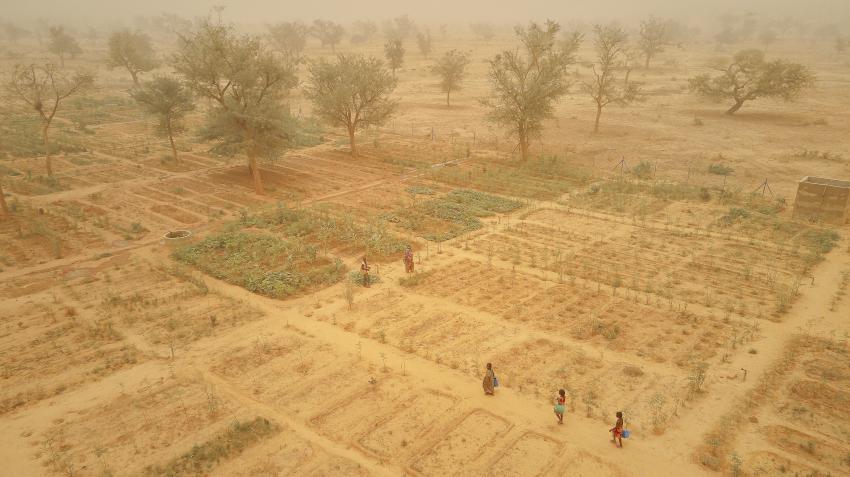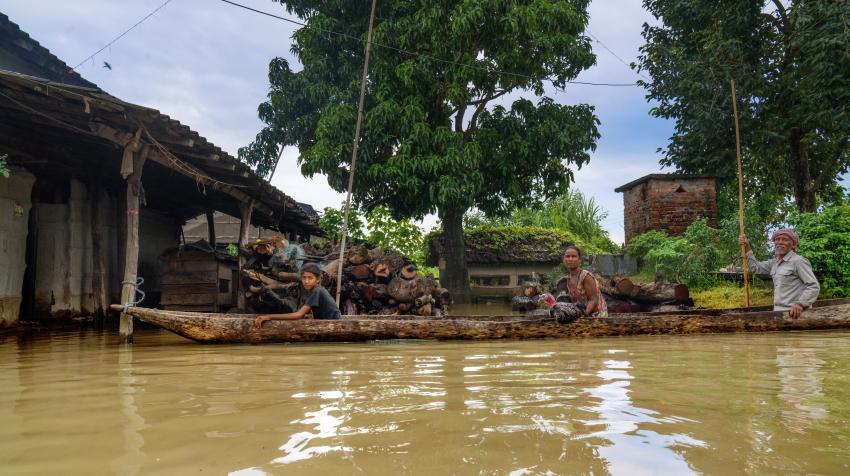13 March 2024
The climate crisis is a humanitarian crisis.
Every year, millions of people face the reality of increasingly intense and frequent climate-related disasters, such as floods, storms, droughts and other extreme weather, killing loved ones and destroying livelihoods.
Since 2000, the escalating climate crisis has also meant an eightfold increase in funding requirements for United Nations humanitarian appeals linked to extreme weather. Too often, climate disasters are compounded by other drivers of humanitarian need, such as conflict and disease.
Looking ahead, the International Federation of Red Cross and Red Crescent Societies (IFRC) estimates a need for an additional $20 billion annually by 2030 to cope with climate-related disasters.
When those furthest behind in terms of development are impacted by disaster, they expect and deserve the United Nations to help them. But that requires funding, which is already woefully short, often comes late, and doesn’t always reach people experiencing complex emergencies.
Being part of the solution
Financing for climate mitigation and adaptation is inadequate and does not reach those who are most vulnerable to, and least responsible for, climate change, nor does it come at the necessary speed or the required scale. The adoption of the decision at the 2023 United Nations Climate Change Conference (COP 28) to operationalize the loss and damage fund and funding arrangements is, therefore, critical.
The United Nations Office for the Coordination of Humanitarian Affairs (OCHA) and the humanitarian community are calling on all countries to live up to their promises on climate finance and give generously to what we hope will be a large, agile and responsive global loss and damage fund.
However, as important as it is, the loss and damage fund will not fill the ever-widening gap in financing for humanitarian action made necessary by the climate crisis. The scope of the new loss and damage fund is meant to complement humanitarian action. Furthermore, evidence shows that available mitigation and adaptation finance does not reach the most vulnerable, particularly those in fragile and conflict-affected communities.
This is why the United Nations launched the Central Emergency Response Fund (CERF) “climate action account” at COP 28 to “help scale anticipatory, early and flexible finance for addressing climate shocks in fragile contexts, while also supporting adaptation co-benefits and strengthened resilience”.
To attract funding from outside of the usual humanitarian funding streams available to CERF, the climate action account allows donors, including States, companies, philanthropists and ordinary people, to contribute directly to the account, with the confidence that CERF will allocate the funds to support communities affected by the climate crisis.
In the words of United Nations Secretary-General António Guterres, the climate action account “will enable donors to channel additional financing directly to address the risks and impacts of climate-related disasters.”

The account thus leverages existing humanitarian financing instruments as a small yet critical part of the global financing arrangements aimed at averting, minimizing and addressing loss and damage associated with climate change impacts.
Addressing the climate crisis
Protecting people from disasters is complicated, difficult and risky. Think of the drylands of East Africa, where droughts, floods, livestock diseases and armed conflicts are wiping out the livelihoods of pastoralist communities.
In the Sahel, successive droughts and floods have kept entire communities in a state of intractable poverty and suffering. In Haiti, most of the internally displaced children have fled their homes due to flooding and crop losses.
In 2005, the General Assembly created CERF, managed under the authority of the Secretary-General, to enable early action and response aimed at reducing loss of life, enhancing response to time-critical requirements and strengthening core elements of humanitarian response in underfunded crises.
Since then, CERF has allocated over $2.1 billion—more than a quarter of its funds—to help more than 462 million people caught up in climate-related disasters across 86 countries through 2,300 projects.
The CERF climate action account offers an efficient and impactful vehicle to get urgently needed resources to where they are needed most. To put it differently, the new climate action account ensures that funding is used to address immediate losses and humanitarian impacts of climate disasters.
Getting ahead of climate-related disasters
In recent years, CERF has also been the main global instrument to provide financing ahead of predictable climate disasters. This anticipatory approach can lead to significantly faster humanitarian action that is more dignified and effective and protects development gains.
Anticipatory action is taken ahead of predicted hazards to prevent or reduce acute humanitarian impacts before they fully unfold. This approach ensures that money translates into action to address disasters before crisis hits.
To work well, speed is of the essence, and the speed that characterizes CERF has been a key part of its unique added value. On average, CERF-funded action starts within less than four days of a request. For anticipatory action, CERF disburses pre-arranged funding even faster based on predictions ahead of the impact of a climate-related disaster.
For example, in 2020 in Bangladesh, CERF provided finance within four hours of the flood warning and days before the waters started to rise. In Nepal in 2023, it took only 14 minutes between the trigger and the release of funds.
Today, CERF is the largest source of pre-arranged funding for anticipatory action in the face of climate-related disasters. In 2023, the Fund also provided more than $124 million for early action, most of which was based on forecasts to get ahead of rising food insecurity, the El Niño phenomenon and flooding.
The CERF climate action account ensures even more funding is used to scale up anticipatory action that helps people minimize the impact of climate disasters before they occur.
Improving people’s future
CERF will not deviate from its humanitarian mandate to provide life-saving assistance based on humanity, neutrality, impartiality and independence. For many years, however, humanitarian actors have aimed to deliver their life-saving mandate in ways that also contributed to communities’ resilience to future shocks. For instance, during droughts, CERF often finances drought-resistant agricultural activities where farmers receive immediate support that may help them through the immediate crisis while also strengthening their capacity to adapt to future drought shocks.

The same is true for rehabilitating boreholes that provide immediate access to safe water for people and livestock while also providing sustainable access to water for a long time to come. A similar case can be made for humanitarian action spanning food security, water and sanitation, as well as health sectors.
There is also growing evidence that unconditional cash transfers can be a valuable tool in helping people adapt to climate change in humanitarian settings. CERF investment in cash programming has almost tripled, from 6 per cent in 2017 to 16 per cent in 2022.
This point was stressed at COP 28 by Joyce Msuya, United Nations Assistant-Secretary-General for Humanitarian Affairs, who said that contributions through the CERF climate action account “will allow the United Nations and its partners to continue to provide swift relief in response to, or in anticipation of, humanitarian disasters wherever they strike, whatever their source, as we move into a world in which climate change holds the sword of Damocles over an increasing number of people”.
As such, the CERF climate action account generates additional incentives to deliver a more efficient and dignified response through humanitarian practices that also support and integrate adaptation to climate change.
The choice is clear
In launching the CERF climate account, OCHA is fully conscious that humanitarian tools are only one small, complementary part of what must be a much broader and more ambitious effort to support governments and affected communities in responding to the ravages of climate change.
There is no humanitarian solution to the climate crisis, yet humanitarians must continue to play their part in tackling its consequences by minimizing and addressing loss and damage and supporting communities in building capacities to face climate shocks.
While the climate crisis looms large, there is reason for hope. The launch of the CERF climate action account fills a critical gap in the mosaic of climate financing arrangements.
The account marks a vital step towards protecting vulnerable communities from devastating impacts of climate-related disasters. By providing anticipatory action and immediate assistance to disasters, the account can enable smart humanitarian action that bridges the gap between humanitarian aid and resilience, empowering communities to better handle a climate crisis.
The CERF climate action account applies a tried and trusted tool towards global solidarity to address growing climate crises. Importantly, it also makes plain the United Nations commitment to leaving no one behind, ensuring that even the most marginalized have access to the resources they need to thrive.
The UN Chronicle is not an official record. It is privileged to host senior United Nations officials as well as distinguished contributors from outside the United Nations system whose views are not necessarily those of the United Nations. Similarly, the boundaries and names shown, and the designations used, in maps or articles do not necessarily imply endorsement or acceptance by the United Nations.




